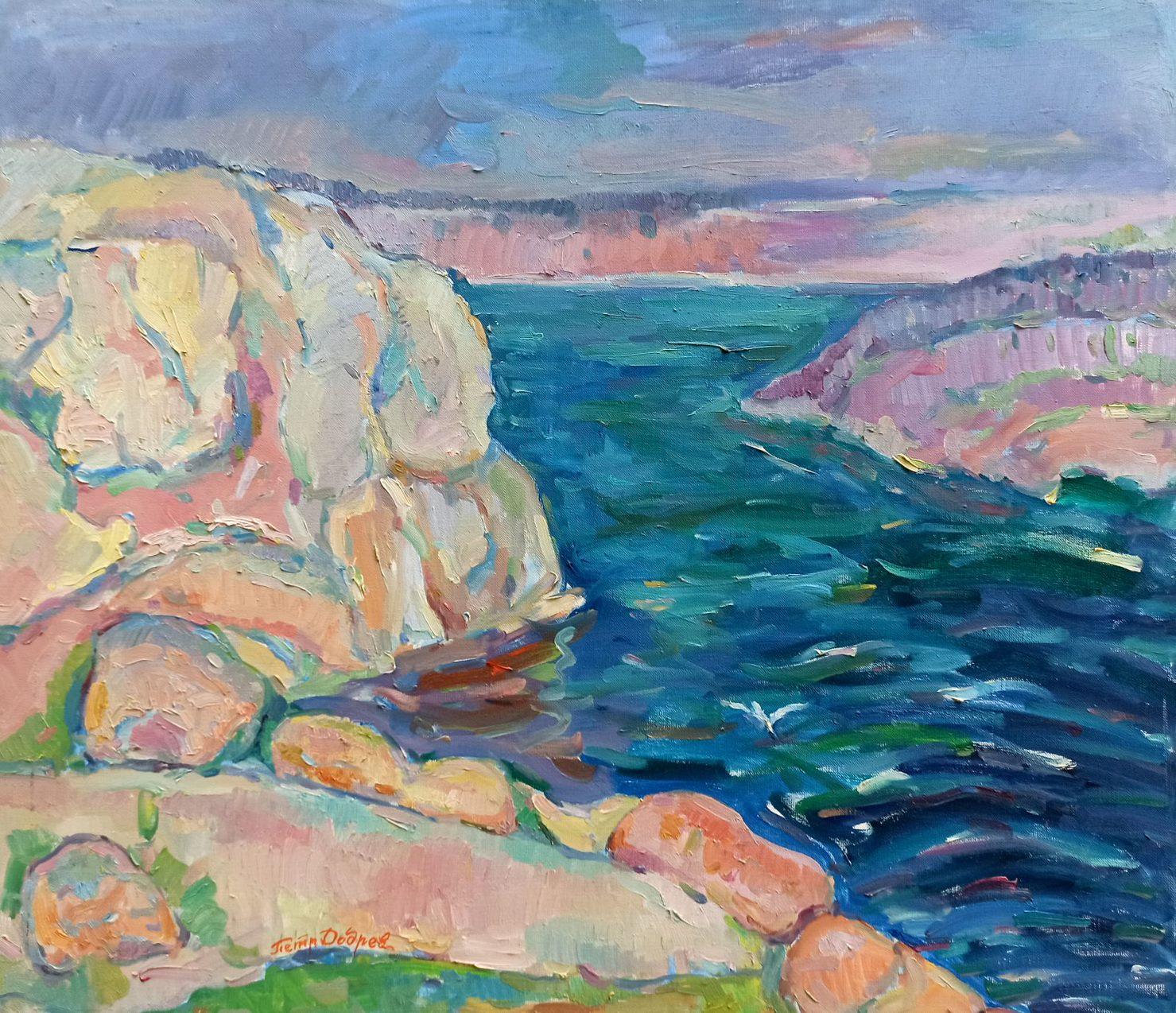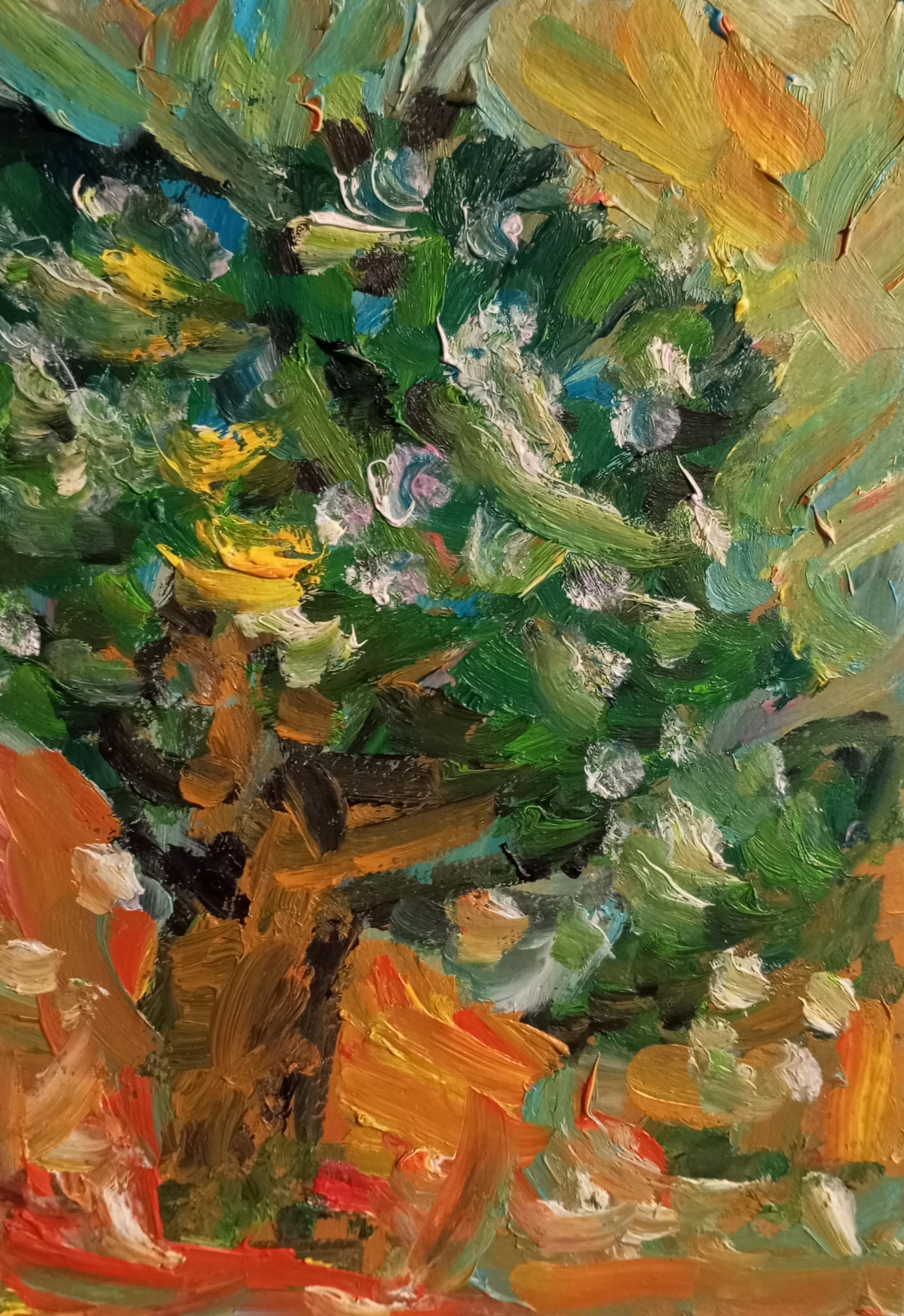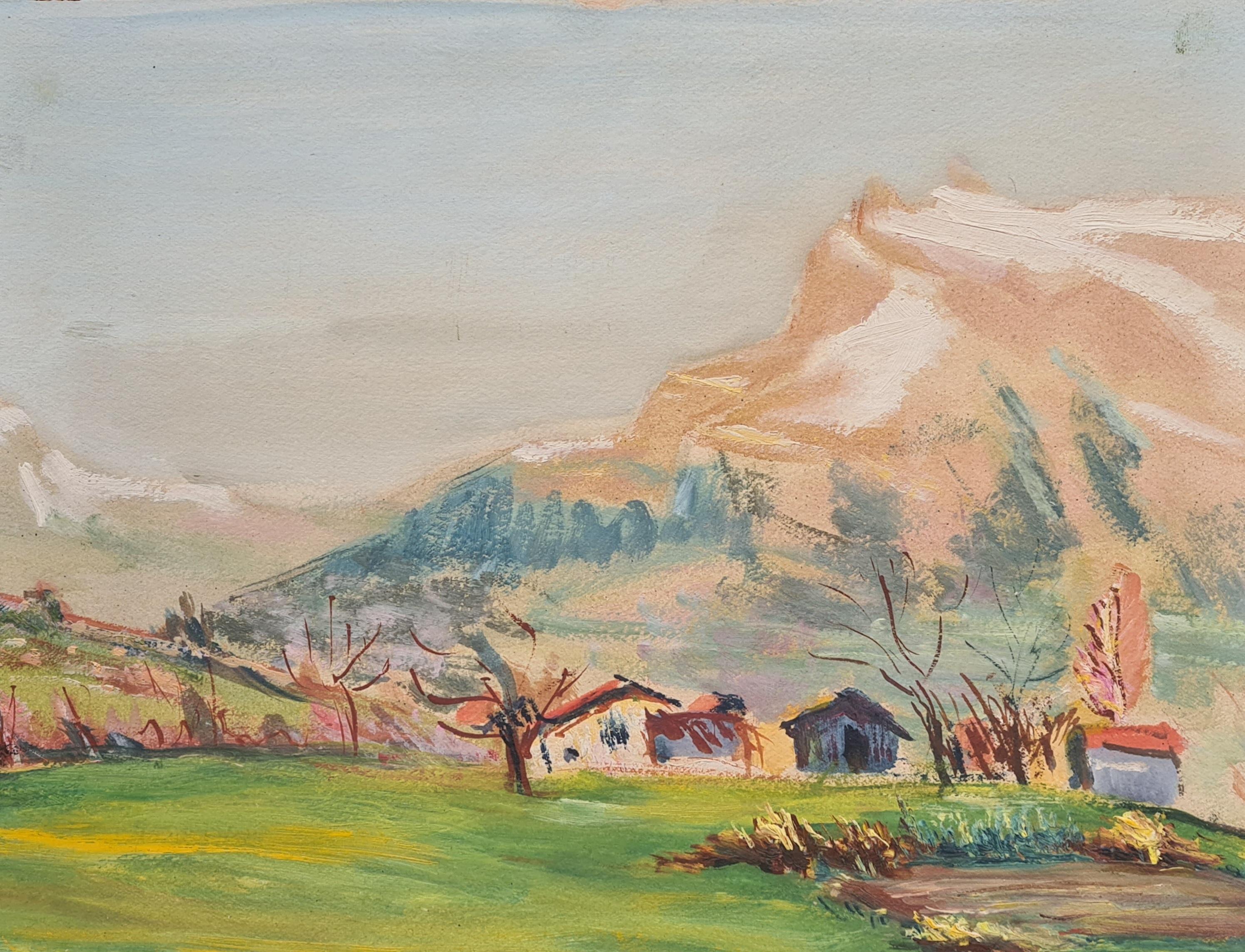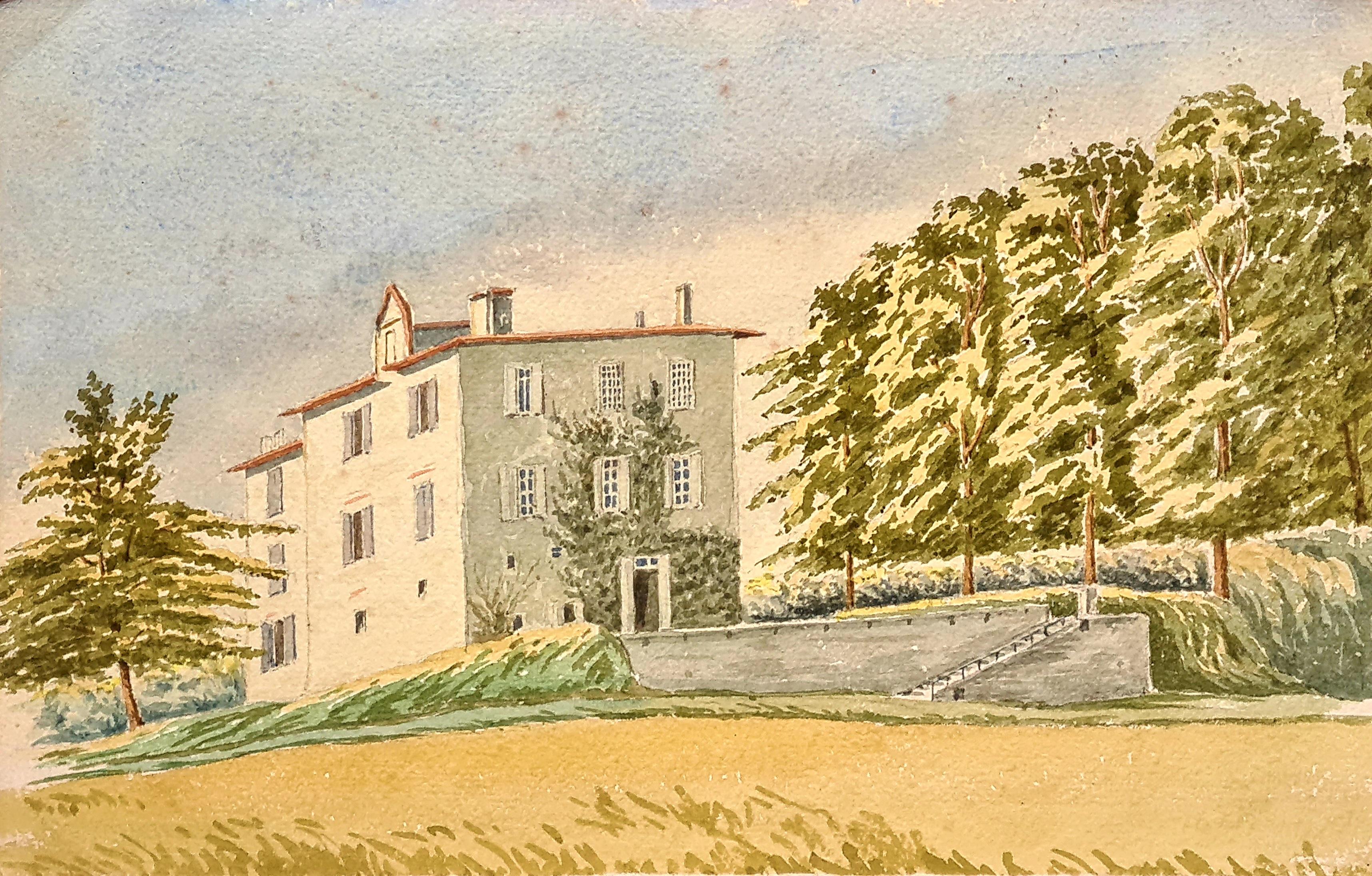Items Similar to Antique French Barbizon Landscape by Charles Donzel (1824-1899)
Want more images or videos?
Request additional images or videos from the seller
1 of 10
Charles DonzelAntique French Barbizon Landscape by Charles Donzel (1824-1899)1850's
1850's
About the Item
Antique landscape oil painting by French artist, Charles Donzel (1824-1889) annotations on the back.
Atmospheric small Barbizon oil painting on wood in a Napoleon III ebony style frame which complements the painting. The board has a dark, and romantically moody with a traditional Barbizan School composition. Dark looming trees provide a womb like effect while rays of light come from the centre. The trees are painted in typical Donzel style, with an animated romantic moodiness.
MORE ABOUT THIS PAINTING:
Medium: Oil on wood
Overall size, including frame: 11ins x 9.5ins or 28cms x 24cms (approx)
Date: Mid 1800's
Condition: The painting, is in good antique condition but you should expect mininmal imperfections associated with age. The frame appears to be the original it has indentations, visible nails at the corners and imperfections throughout as you would expect from an item of this age.
Signed: No, but the style is unmistakable and the painting has annotations on the back. Charles Donzel (1824-1889) Born 6 February 1824, in Besançon; died 20 March 1889, in Paris. He was a painter of landscapes as well as a watercolourist and draughtsman. He was of the Barbizon School of painters.
Charles Donzel studied music and sculpture before opting for painting. He exhibited at the Paris Salon from 1859. Donzel settled in Limoges, where he occasionally worked on decorating ceramics at the Pouyot works.
Donzel's friends Corot, Troyon and Daubigny nicknamed him the 'painter of the waters' in recognition of the fact that water is a key component of his landscapes of the Limousin, Franche-Comté, Maine and Normandy regions. His watercolour work exhibits a similar limpidity.
This painting is shipped by Colissimo track and trace and fully insured
- Creator:Charles Donzel (1824 - 1899, French)
- Creation Year:1850's
- Dimensions:Height: 9.5 in (24.13 cm)Width: 11 in (27.94 cm)
- Medium:
- Movement & Style:
- Period:
- Condition:
- Gallery Location:AIGNAN, FR
- Reference Number:1stDibs: LU2448214425892
About the Seller
5.0
Platinum Seller
These expertly vetted sellers are 1stDibs' most experienced sellers and are rated highest by our customers.
Established in 2021
1stDibs seller since 2023
33 sales on 1stDibs
Typical response time: <1 hour
- ShippingRetrieving quote...Ships From: AIGNAN, France
- Return PolicyA return for this item may be initiated within 2 days of delivery.
Auctions on 1stDibs
Our timed auctions are an opportunity to bid on extraordinary design. We do not charge a Buyer's Premium and shipping is facilitated by 1stDibs and/or the seller. Plus, all auction purchases are covered by our comprehensive Buyer Protection. Learn More
More From This SellerView All
- Antique landscape, riverscape oil painting by Pierre Louis CazaubonLocated in AIGNAN, FRAntique French riverscape/landscape in a beautiful ornate frame by French artist, Pierre Louis Cazaubon, signed in the lower right corner. This attractive post-impressionist oil on ...Category
1910s Post-Impressionist Landscape Paintings
MaterialsOil
- Antique figurative oil painting, Landscape, Riverscape, French artBy Pierre GarnierLocated in AIGNAN, FRAntique French landscape oil painting/figurative oil painting of a woman at the edge of the water by Pierre Garnier, signed in the bottom left...Category
1890s French School Landscape Paintings
MaterialsOil
- Landscape oil Painting, Garden landscape, mountain landscape, French artLocated in AIGNAN, FRVintage landscape oil painting on canvas by French artist Marie Marguerite Reol (1880-1963) Garden landscape in the fore with a backdrop of mountains, most likely to be the Pyrenees....Category
1930s Post-Impressionist Landscape Paintings
MaterialsOil
- Vintage Landscape Oil Painting of a Chateau & Park, signed and dated 1944Located in AIGNAN, FRUnusual vintage landscape oil painting by French artist, Alban Taracole (1881-1968). Animated scene of a chateau and parc with people enjoying the sunshine on an early Spring day. ...Category
1940s Post-Impressionist Landscape Paintings
MaterialsOil
- Antique landscape sunset and cows, Les Vaches by Adolphe PotterBy Adolphe PotterLocated in AIGNAN, FRLes Vaches by Adolphe Potter (1835-1911) Antique countryside sunset oil painting with cows on wood, signed in the bottom right Adople Potte (1835-1911). This distinctive oil painti...Category
1860s Impressionist Landscape Paintings
MaterialsOil
- Antique French Landscape oil painting of a park dated 1892Located in AIGNAN, FRPark Pathway dated 1892 Atmospheric old oil painting on canvas dated 1892. This gorgeous old wooded parkland painting with a sunlight highlighted pathway is quite magical. The dark...Category
1890s French School Landscape Paintings
MaterialsOil
You May Also Like
- Waiting by Jozef Israëls - Landscape oil paintingBy Jozef IsraëlsLocated in London, GBWaiting by Jozef Israëls (1824-1911) Oil on canvas 95.3 x 133.9 cm (37 ½ x 52 ¾ inches) Signed lower left, Jozef Israels A monumental painting by one of...Category
19th Century Barbizon School Figurative Paintings
MaterialsCanvas, Oil
- The Barn, Oil On Bord, Signed Jean-Charles Cazin, Barbizon School, 1865By Jean-Charles CazinLocated in Paris, FROil on panel representing a barn, signed JC Cazin on the lower left corner. Jean Charles Cazin (1840-1901) Born in Samer (his father, from Bologna,...Category
Late 19th Century Barbizon School Landscape Paintings
MaterialsOil
- Oil Painting 19th Century Cows Landscape BarbizonBy Antonio CortesLocated in Saint-Ouen, FRCORTES Antonio (1827-1908) Cows to pasture Oil on canvas signed lower left Old frame gilded with leaves Dim canvas : 54 X 65 cm Dim frame: 70 x 86 cm...Category
1860s Barbizon School Animal Paintings
MaterialsOil
- Barbizon School Lakeside Landscape With CastleLocated in Cotignac, FRAn oil on panel idyllic landscape by Boggio. The painting is signed bottom right. An idealised lakeside landscape view with a castle in the distance in the style of the Barbizon sch...Category
Mid-20th Century Barbizon School Landscape Paintings
MaterialsOil, Board
- Barbizon School Lakeside Landscape, The Shady Glen.Located in Cotignac, FRAn oil on panel idyllic landscape by Boggio. The painting is signed bottom right. An idealised lakeside landscape view of a shady glen in the style of the Barbizon school.Category
Mid-20th Century Barbizon School Landscape Paintings
MaterialsOil, Board
- The Forest, Large Barbizon School, Oil on Canvas Wooded LandscapeBy Emile Roux-FabreLocated in Cotignac, FRA French Barbizon School oil on canvas forest view by Emile Roux-Fabre. The painting is signed and dated bottom left with a dedication. A charming view of forest glade leading out to a valley landscape beyond. The artist has captured the magic feeling of the cool forest shade against the sunshine of the landscape beyond. The texture of the bark on the silver birch trees, the contrast of the leaves on the trees all framing the perspective to the view beyond. An extremely accomplished and atmospheric painting. The Barbizon school of painters was part of an art movement towards Realism in art, which arose in the context of the dominant Romantic Movement of the time. The Barbizon school was active roughly from 1830 through 1870. It takes its name from the village of Barbizon, France, on the edge of the Forest of Fontainebleau, where many of the artists gathered. Most of their works were landscape paintings, but several of them also painted landscapes with farmworkers, and genre scenes of village life. Some of the most prominent features of this school are its tonal qualities, colour, loose brushwork, and softness of form. The leaders of the Barbizon school were: Théodore Rousseau, Charles-François Daubigny, Jules Dupré, Constant Troyon, Charles Jacque, and Narcisse Virgilio Díaz. Jean-François Millet lived in Barbizon from 1849, but his interest in figures with a landscape backdrop sets him rather apart from the others. Jean-Baptiste-Camille Corot was the earliest on the scene, first painting in the forest in 1829, but his work has a poetic and literary quality which sets him somewhat apart. Other artists associated with the school, often pupils of the main group, include: Henri Harpignies, Albert Charpin, François-Louis Français and Émile van Marcke. In 1824 the Salon de Paris exhibited works of John Constable, an English painter. His rural scenes influenced some of the younger artists of the time, moving them to abandon formalism and to draw inspiration directly from nature. Natural scenes became the subjects of their paintings rather than mere backdrops to dramatic events. During the Revolutions of 1848 artists gathered at Barbizon to follow Constable's ideas, making nature the subject of their paintings. The French landscape became a major theme of the Barbizon painters. Millet extended the idea from landscape to figures — peasant figures, scenes of peasant life, and work in the fields. In The Gleaners (1857), for example, Millet portrays three peasant women working at the harvest. Gleaners are poor people who are permitted to gather the remains after the owners of the field complete the main harvest. The owners (portrayed as wealthy) and their laborers are seen in the back of the painting. Millet shifted the focus and the subject matter from the rich and prominent to those at the bottom of the social ladders. To emphasize their anonymity and marginalized position, he hid their faces. The women's bowed bodies represent their everyday hard work. In the spring of 1829, Jean-Baptiste-Camille Corot came to Barbizon to paint in the Forest of Fontainebleau, he had first painted in the forest at Chailly in 1822. He returned to Barbizon in the autumn of 1830 and in the summer of 1831, where he made drawings and oil studies, from which he made a painting intended for the Salon of 1830; "View of the Forest of Fontainebleau'" (now in the National Gallery in Washington) and, for the salon of 1831, another "View of the Forest of Fontainebleau"'. While there he met the members of the Barbizon school: Théodore Rousseau, Paul Huet, Constant Troyon, Jean-François Millet, and the young Charles-François Daubigny. During the late 1860s, the Barbizon painters attracted the attention of a younger generation of French artists studying in Paris. Several of those artists visited Fontainebleau Forest to paint the landscape, including Claude Monet, Pierre-Auguste Renoir, Alfred Sisley and Frédéric Bazille. In the 1870s those artists, among others, developed the art movement called Impressionism and practiced 'plein air' painting. In contrast, the main members of the school made drawings and sketches on the spot, but painted back in their studios. The Post-Impressionist painter Vincent Van Gogh studied and copied several of the Barbizon painters as well, including 21 copies of paintings by Millet. He copied Millet more than any other artist. He also did three paintings in Daubigny's Garden. The Barbizon painters also had a profound impact on landscape painting in the United States. This included the development of the American Barbizon school by William Morris Hunt. Several artists who were also in, or contemporary to, the Hudson River School studied Barbizon paintings for their loose brushwork and emotional impact. A notable example is George Inness, who sought to emulate the works of Rousseau. Paintings from the Barbizon school also influenced landscape painting in California. The artist Percy Gray...Category
Early 20th Century Barbizon School Landscape Paintings
MaterialsCanvas, Oil





